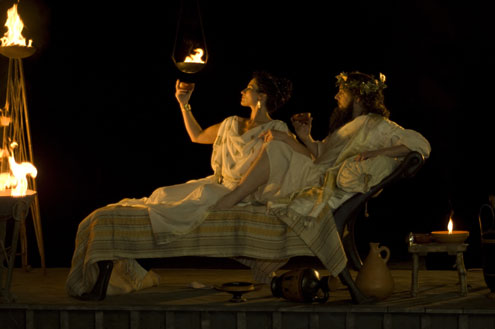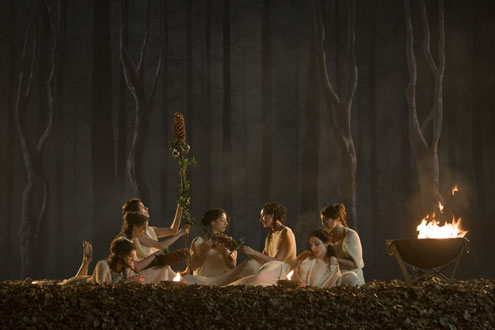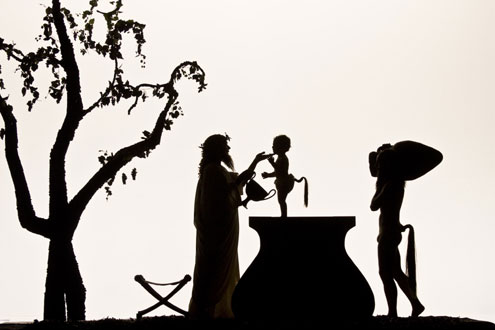Lifestyles
Sixty-sixth Annual Venice Film Festival selects the 'The Death of Pentheus' by Philip Haas and commissioned by The Kimbell Art Museum
By The Kimbell Art Museum
Sep 26, 2009
FORT WORTH, TEXAS—The Death of Pentheus, by distinguished filmmaker Philip Haas, was chosen for the 66th Mostra Internazionale d’Arte Cinematografica, held in Venice, Italy. The Venice International Film Festival, September 2 through 12, 2009, is the oldest and most prestigious in the film industry.
The film will be shown as part of the Orizzonti, or new trends in cinema, section. It is one of five films by Haas that were commissioned by the Kimbell Art Museum for its current exhibition, Butchers, Dragons, Gods and Skeletons: Film Installations by Philip Haas Inspired by Works in the Collection.
The first film to be completed, The Butcher’s Shop, won the “Premio Open” at the 2008 festival, an award for films that bridge cinema and art. The Death of Pentheus is based on a Greek vase showing the death of Pentheus and a maenad, from circa 480 B.C.
 |
| Dionysus and Ariadne, from the film installation The Death of Pentheus |
Malcolm Warner, the Kimbell’s deputy director and curator of the Philip Haas exhibition at the Museum, commented, “We’re delighted that this film commissioned by the Kimbell is to be shown at the Venice Film Festival. Taking an ancient Greek vase in the Kimbell’s collection as his inspiration and starting point, Philip Haas has conjured up the very spirit of Dionysus, the god of wine, sensuality, and abandon. It’s a work of great power that uses the means of modern art and film to capture an elemental and eternal theme.”
 |
| Maenads in the woods, from the film installation The Death of Pentheus |
“I'm very happy to be returning for a second year running at the Venice Film Festival to screen another work from the Butchers, Dragons, Gods and Skeletons series,” said filmmaker Philip Haas. “The Festival is the ideal international venue to platform my collaboration with the Kimbell Art Museum.”
 |
| Dionysus teaching a child satyr to drink wine from the film installation The Death of Pentheus |
Butchers, Dragons, Gods and Skeletons
Film Installations by Philip Haas Inspired by Works in the Collection -- On View at the Kimbell Art Museum through October 25, 2009
Creatively interpreting and elaborating upon works in the Kimbell Art Museum’s permanent collection, Haas explores what is effectively a new art form, treating art as a subject in film pieces that are powerful works of art in themselves. At the heart of Haas’s installations are short films that give form to ideas and feelings suggested by the chosen works from the collection. Though based on deep research into the original artists and cultures, they are poetic and sensuous in approach rather than factual like a documentary. On occasion actors, dancers, and settings form themselves into an ingenious, at times uncanny re-creation of the given work, as though it were a still that magically preceded the film to which it belongs. Allusions to other, related works of art further enrich the imagery. All five are accompanied by original music, and three appear in elaborate architectural and sculptural sets, further immersing the viewer in the experience.
Philip Haas
Philip Haas’s best-known feature film is the Oscar-nominated Angels and Insects (1995), based on the novella by A. S. Byatt, starring Kristin Scott Thomas and Mark Rylance. Angels and Insects premiered in competition at the Cannes Film Festival, and in the year of its release was the top-grossing American independent film. Haas has directed five other feature films, including The Music of Chance (1993), adapted from the novel by Paul Auster, starring James Spader, Mandy Patinkin, Charles Durning, and Joel Grey; Up at the Villa (2000), with Sean Penn, Anne Bancroft, Derek Jacobi, and Kristin Scott Thomas; and The Situation (2007), the first American feature film dealing with the war in Iraq, starring Connie Nielsen.
Before becoming a filmmaker, Haas studied art history at Harvard. In addition to his feature films, he has made ten documentaries with visual artists. The subjects range from Gilbert & George and David Hockney––on Chinese painting––to Australian aboriginal ground painters and the funerary sculptors of Madagascar. Retrospectives of the documentaries have been held at the National Gallery of Art in Washington, the Museum of Fine Arts in Boston, the Film Society of Lincoln Center in New York, the Tate in London, and the Centre Georges Pompidou in Paris. For his documentary work, Haas was awarded a fellowship from the Guggenheim Foundation.
Philip Haas’s film installation work and paintings are represented by the Sonnabend Gallery in New York. He has taught in the creative writing and visual arts departments at Princeton.
66th Venice International Film Festival
The 66th Venice International Film Festival is organized by the Venice Biennale and will run from September 2 through 12, 2009, at Venice Lido. The aim of the festival is to promote international cinema in all its forms––as art, as entertainment and as an industry––in a spirit of freedom and tolerance. The festival will include retrospectives and homages to major figures in an effort to raise awareness of the history of cinema. www.labiennale.org
Kimbell Art Museum
Owned and operated by the Kimbell Art Foundation, the Kimbell Art Museum opened to the public in 1972. Its collections range in period from antiquity to the 20th century, including signature examples by European masters from Duccio, Fra Angelico and Caravaggio to Cézanne and Matisse, and selected holdings of Egyptian, Near Eastern, Greek, and Roman antiquities, as well as Asian, Mesoamerican, and African arts. The Kimbell’s building, designed by Louis Kahn, is widely regarded as one of the supreme architectural achievements of the modern era.



